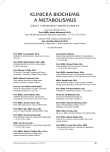Comparison of different electrophoretic systems in the laboratory diagnosis of monoclonal gammopathy
Authors:
P. Kušnierová 1,2; D. Zeman 1,2; I. Faruzelová 1; F. Všianský 1; Z. Švagera 1,2; K. Šafarčík 1,2
Authors‘ workplace:
Ústav laboratorní diagnostiky, Oddělení klinické biochemie, Fakultní nemocnice Ostrava
1; Katedra biomedicínských oborů, Lékařská fakulta, Ostravská univerzita
2
Published in:
Klin. Biochem. Metab., 26, 2018, No. 2, p. 82-86
Overview
Objective:
Comparison of densitometric/absorbance values of individual electrophoretic fractions and paraprotein concentrations using three electrophoretic systems.
Type:
Methodical study. Material and methods: 206 samples of patients with suspected or diagnosed monoclonal gammopathy that had been sent for serum protein electrophoresis to the Dept. of Clinical Biochemistry, Institute of Laboratory Diagnostics, University Hospital Ostrava, were included in the study. For serum protein electrophoresis, three systems were used: Hydrasys, Capillarys 2 Flex - Piercing and Interlab G-26 Easy-Fix. For statistical analysis, programme MedCalc Version 16.1.2 was used.
Results:
T-test showed that best precision in condition of repeatability had been achieved by Capillarys (CV < 4.1 %) followed by Interlab G26 (CV < 5.7 %) and Hydrasys (CV <10 %). For the analysis of differences between the instruments by a non-parametric Friedman´s test, statistically significant differences were found in each comparison for albumin, α2-, β1 - and β2-globulins. For α1-globulins, no significant difference was found between Interlab G26 and Hydrasys; for γ-globulins, no significant difference was found between Interlab G26 and Capillarys. Monoclonal komponent was found in 79 samples by all the systems used. No significant differences in paraprotein concentrations between Hydrasys and Interlab G26 were found, and these concentrations were not dependent on the paraprotein type.
Conclusion:
Systems working on the principle of gel electrophoresis provide comparable results and they are interchangeable.
Keywords:
serum protein gel electrophoresis, capillary electrophoresis, monoclonal gammopathy.
Sources
1. Katzmann, J. A. Screening Panels for Monoclonal Gammopathies: Time to Change. Clin Biochem Rev., 2009, 30(3), p. 105-111.
2. Attaelmannan, M., Levinson, S. S. Understanding and identifying monoclonal gammopathies. Clin Chem., 2000, 46(8), p. 1230-1238.
3. Sethi, S., Rajkumar, S. V. Monoclonal gammopathy-associated proliferative glomerulonephritis. Mayo Clin. Proc., 2013, 88(11), p. 1284-1293.
4. Pika, T., Lochman, P., Minařík, J., Bačovský, J., Ščudla, V. Úskalí interpretace výsledků společné analýzy hladin volných lehkých řetězců a elektroforézy séra. Klin. Biochem. Metab., 2012, 20(41), p. 59–62.
5. Landgren, O., Kyle, A. R., Pfeiffer, R. M., Katzmann, J. A., Caporaso, N. E., Hayes, R. B., Dispenzieri, A., Kumar, S., Clark, R. J., Baris, D., Hoover, R., Rajkumar, S. V. Monoclonal gammopathy of undetermined significance (MGUS) consistently precedes multiple myeloma: a prospective study. Blood, 2009, 113(22), p. 5412–5417.
6. Maisnar, V. Riziko přechodu monoklonální gamapatie nejasného významu do maligní monoklonální gamapatie. Klin. Biochem. Metab., 2013, 21(42), p. 93–96.
7. Keren, D. F., Schroeder, L. Challenges of measuring monoclonal proteins in serum. Clin. Chem. Lab. Med., 2016, 54(6), p. 947-961.
8. Katzmann, J. A., Snyder, M. R., Rajkumar, S. V., Kyle, R. A., Therneau, T. M., Benson, J. T., Dispen-zieri, A. Long-Term Biological Variation of Serum Protein, Electrophoresis M-Spike, Urine M-Spike, and Monoclonal Serum Free Light Chain Quantification: Implications for Monitoring Monoclonal Gammopathies. Clin. Chem., 2011, 57(12), p. 1687–1692.
9. Mussap, M., Pietrogrande, F., Ponchia, S., Stefani, P. M., Sartori, R., Plebani, M. Measurement of serum monoclonal components: comparison between densitometry and capillary zone electrophoresis. Clin. Chem. Lab. Med., 2006, 44(5), p. 609-611.
10. Schild, C., Wermuth, B., Trapp-Chiappini, D., Egger, F., Nuoffer, J. M. Reliability of M protein quantification: comparison of two peak integration methods on Capillarys 2. Clin. Chem. Lab. Med., 2008, 46(6), p. 876-877.
Labels
Clinical biochemistry Nuclear medicine Nutritive therapistArticle was published in
Clinical Biochemistry and Metabolism

2018 Issue 2
Most read in this issue
- Definition of sepsis and septic shock
- Glycated albumin in blood serum/plasma. Brief overview of the current state.
- Neurofilaments in traumatic brain injury – current knowledge
- Comparison of different electrophoretic systems in the laboratory diagnosis of monoclonal gammopathy
